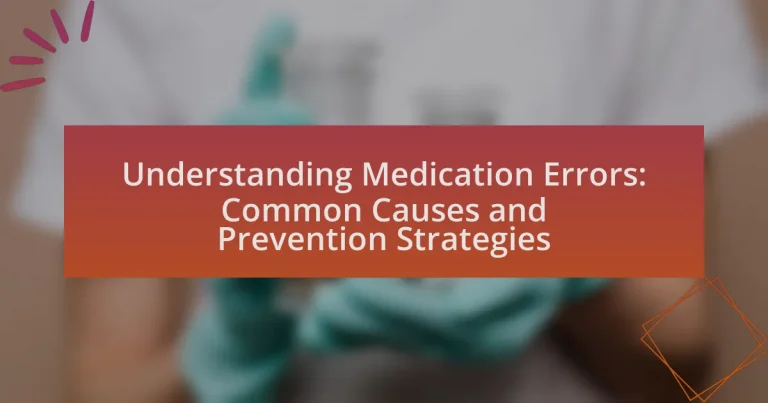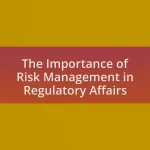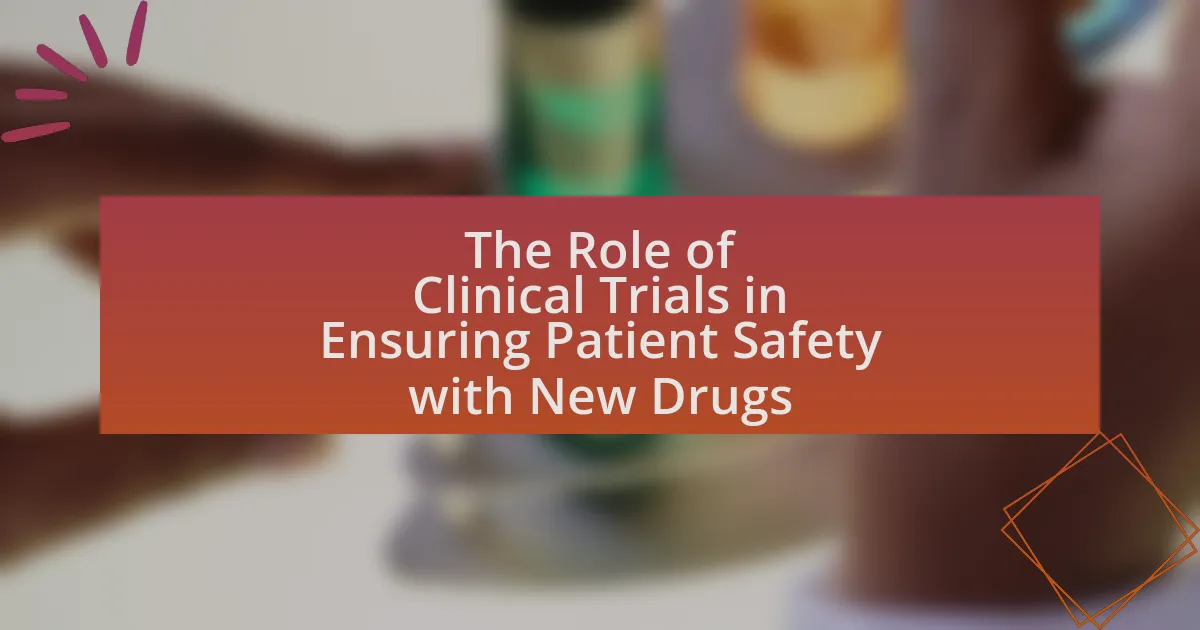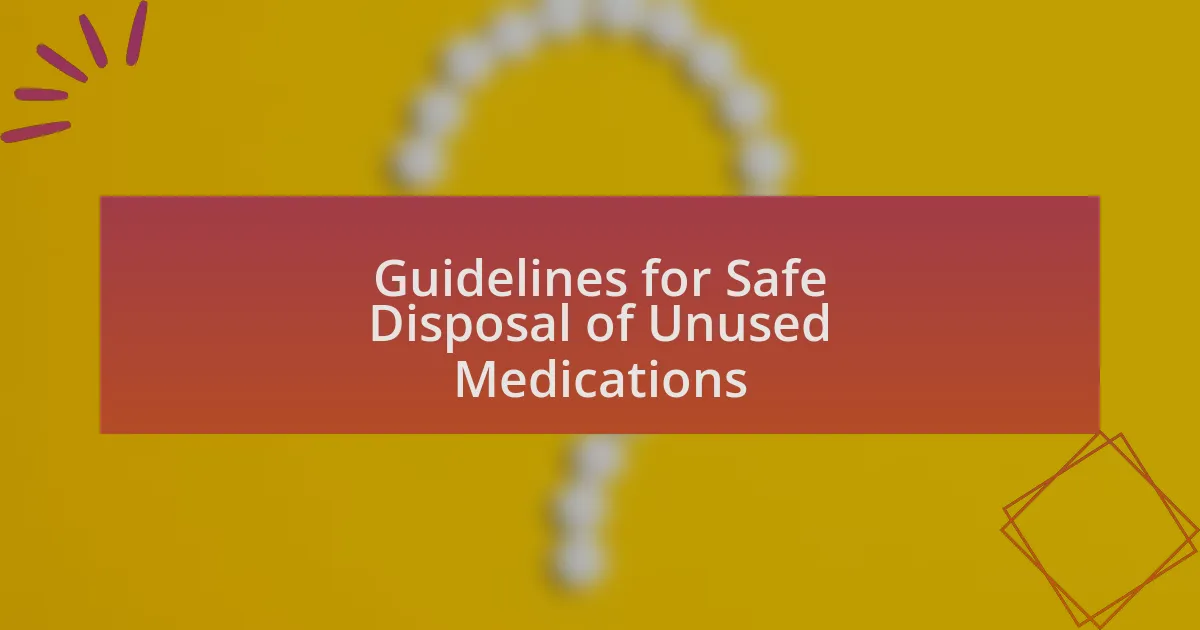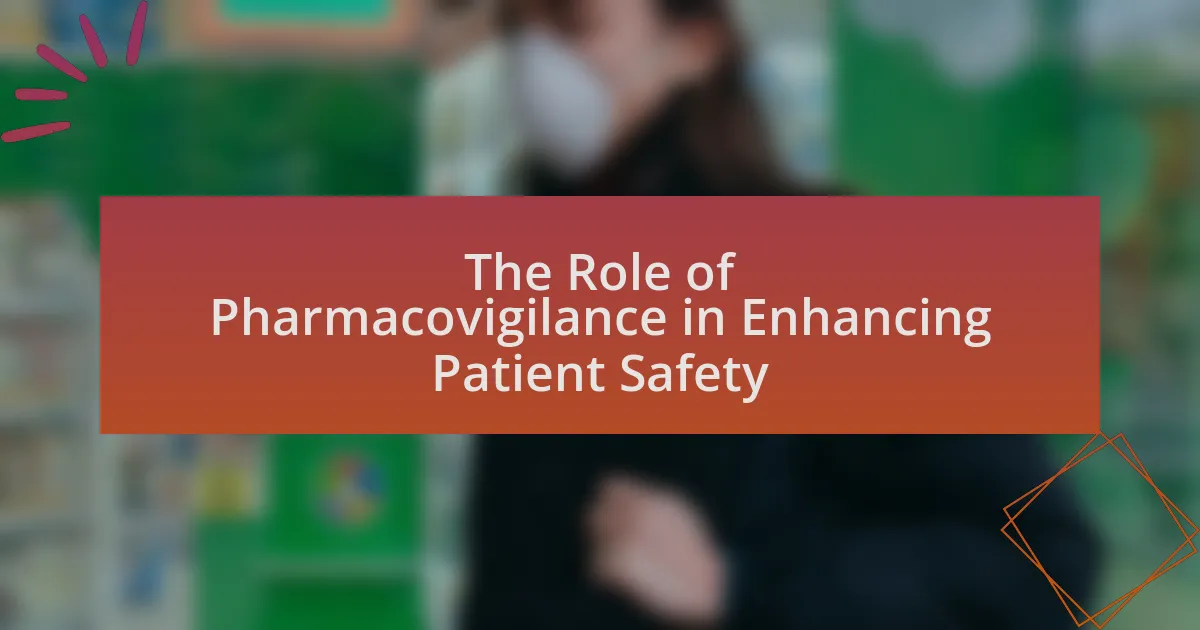Medication errors are mistakes that occur during the prescribing, dispensing, or administration of medications, potentially causing significant harm to patients. These errors can stem from various factors, including miscommunication, incorrect dosages, and inadequate patient information, affecting approximately 1.5 million individuals annually in the United States. The article explores the different types of medication errors, the critical role healthcare professionals play, and the impact on patient safety and healthcare costs. It also highlights common causes, including communication breakdowns and technology-related issues, while presenting effective prevention strategies such as standardized protocols, staff education, and patient involvement to enhance medication safety.
What are Medication Errors?
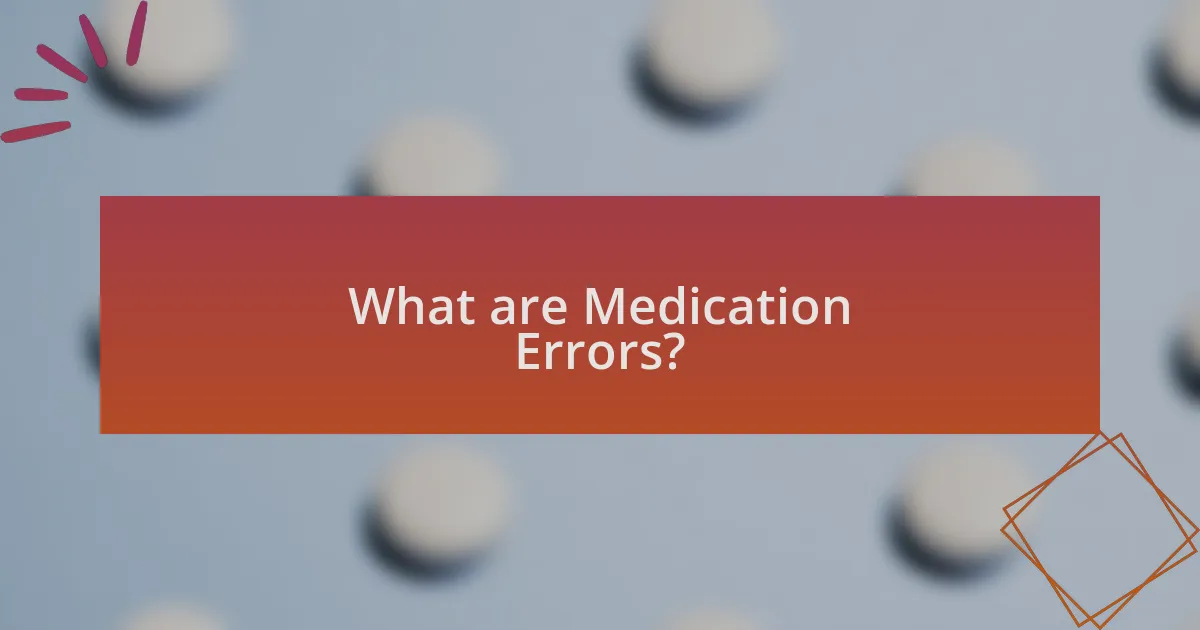
Medication errors are mistakes that occur in the prescribing, dispensing, or administration of medications, leading to potential harm to patients. These errors can arise from various factors, including miscommunication, incorrect dosages, or failure to account for patient allergies. According to the Institute of Medicine, medication errors harm at least 1.5 million people annually in the United States, highlighting the critical need for effective prevention strategies.
How do medication errors occur?
Medication errors occur primarily due to miscommunication, misinterpretation, or oversight in the prescribing, dispensing, or administration of medications. Factors contributing to these errors include similar drug names, unclear handwriting, and inadequate patient information. According to the Institute of Medicine, medication errors harm at least 1.5 million people annually in the United States, highlighting the prevalence and impact of these mistakes.
What are the different types of medication errors?
The different types of medication errors include prescribing errors, dispensing errors, administration errors, and monitoring errors. Prescribing errors occur when the wrong medication, dose, or route is ordered by a healthcare provider. Dispensing errors happen when a pharmacist provides the incorrect medication or dosage to a patient. Administration errors involve mistakes made during the actual giving of the medication, such as incorrect timing or method of administration. Monitoring errors refer to failures in observing the effects of the medication on the patient, which can lead to adverse reactions going unnoticed. These classifications help in identifying and addressing the various points at which errors can occur in the medication use process.
What role do healthcare professionals play in medication errors?
Healthcare professionals play a critical role in medication errors, as they are responsible for prescribing, dispensing, and administering medications. Their actions directly influence the accuracy of medication management, and lapses in their duties can lead to significant errors. For instance, studies indicate that approximately 50% of medication errors occur during the prescribing phase, highlighting the importance of accurate communication and decision-making by healthcare providers. Additionally, factors such as workload, inadequate training, and poor communication among healthcare teams can exacerbate the risk of errors, underscoring the need for systematic improvements in healthcare practices to enhance patient safety.
Why is it important to understand medication errors?
Understanding medication errors is crucial because they can lead to significant patient harm, including adverse drug reactions, prolonged hospital stays, and even fatalities. Research indicates that medication errors affect approximately 1.5 million people annually in the United States alone, highlighting the need for awareness and prevention strategies. By understanding the causes and implications of these errors, healthcare professionals can implement effective measures to enhance patient safety and improve overall healthcare outcomes.
What impact do medication errors have on patient safety?
Medication errors significantly compromise patient safety by leading to adverse drug events, increased morbidity, and even mortality. These errors can result from incorrect dosages, wrong medications, or improper administration routes, which can cause harmful side effects or ineffective treatment. According to a study published in the Journal of Patient Safety, medication errors contribute to approximately 7,000 deaths annually in the United States alone. Furthermore, the National Coordinating Council for Medication Error Reporting and Prevention indicates that these errors can lead to extended hospital stays and increased healthcare costs, highlighting their detrimental impact on overall patient safety.
How do medication errors affect healthcare costs?
Medication errors significantly increase healthcare costs by leading to additional treatments, extended hospital stays, and increased liability expenses. A study published in the Journal of Patient Safety estimated that medication errors cost the U.S. healthcare system approximately $21 billion annually. These costs arise from the need for corrective interventions, management of adverse drug events, and the potential for legal claims against healthcare providers. Thus, medication errors not only compromise patient safety but also impose a substantial financial burden on the healthcare system.
What are the Common Causes of Medication Errors?
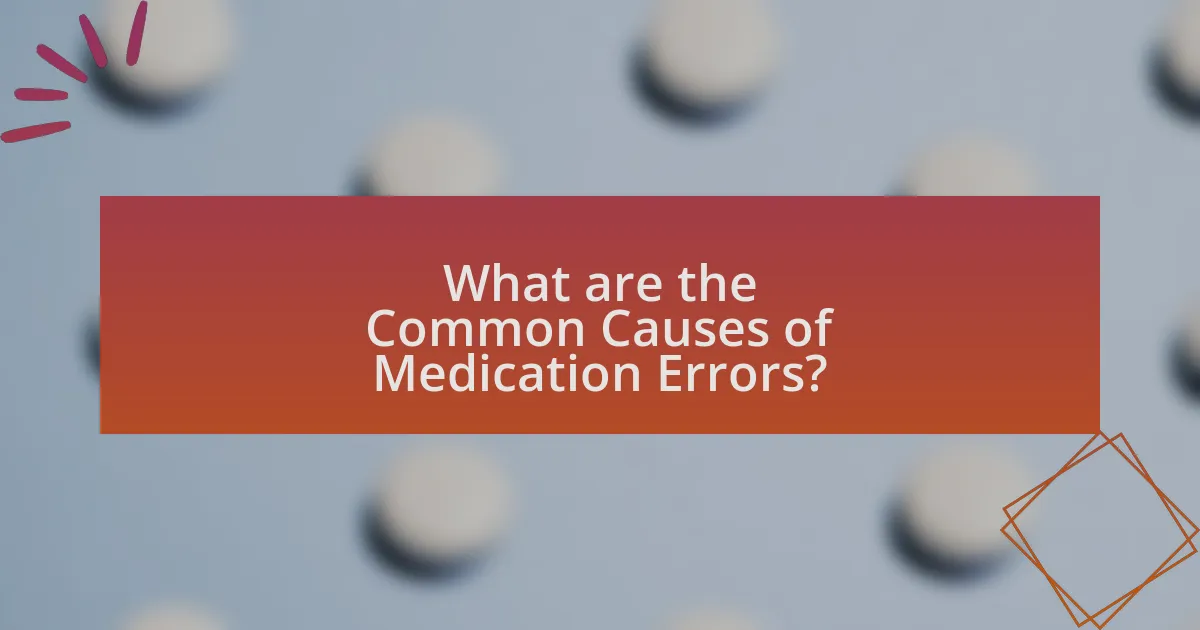
Common causes of medication errors include miscommunication, inadequate knowledge of medications, and system failures. Miscommunication often occurs during verbal orders or handoffs between healthcare providers, leading to incorrect dosages or medications being administered. Inadequate knowledge can stem from insufficient training or unfamiliarity with specific drugs, resulting in errors in prescribing or dispensing. System failures, such as poor electronic health record systems or lack of standardized protocols, can also contribute to medication errors by creating opportunities for mistakes in the medication administration process. According to a study published in the Journal of Patient Safety, approximately 1.5 million preventable adverse drug events occur annually in the United States, highlighting the significance of these common causes.
How do communication issues contribute to medication errors?
Communication issues significantly contribute to medication errors by leading to misunderstandings regarding medication orders, dosages, and administration instructions. For instance, unclear verbal communication between healthcare providers can result in incorrect medication being administered, as evidenced by a study published in the Journal of Patient Safety, which found that 70% of medication errors were linked to communication failures. Additionally, poor documentation practices can exacerbate these issues, as incomplete or illegible records may prevent healthcare professionals from accessing accurate patient information, further increasing the risk of errors.
What are the common communication breakdowns in healthcare settings?
Common communication breakdowns in healthcare settings include misinterpretation of medical information, lack of clarity in verbal and written communication, and inadequate handoff processes between healthcare providers. Misinterpretation often occurs due to medical jargon that patients may not understand, leading to confusion about treatment plans. Lack of clarity can result from poorly written prescriptions or instructions, which increases the risk of medication errors. Inadequate handoff processes, where critical patient information is not effectively communicated during transitions of care, can lead to significant gaps in patient safety. According to a study published in the Journal of Patient Safety, communication failures contribute to approximately 70% of sentinel events in healthcare, highlighting the critical need for improved communication strategies to enhance patient safety and reduce medication errors.
How can misinterpretation of prescriptions lead to errors?
Misinterpretation of prescriptions can lead to medication errors by causing incorrect dosages, wrong medications, or inappropriate administration routes. When healthcare professionals misread or misunderstand prescription instructions, patients may receive medications that do not align with their treatment needs, potentially resulting in adverse drug reactions or therapeutic failures. For instance, a study published in the Journal of the American Medical Association found that nearly 1 in 5 prescriptions contained errors due to misinterpretation, highlighting the critical need for clear communication and standardized prescription formats to minimize such risks.
What role does technology play in medication errors?
Technology plays a significant role in medication errors by both contributing to and helping to prevent them. Electronic health records (EHRs) and computerized physician order entry (CPOE) systems can lead to errors due to issues like incorrect data entry or system malfunctions. For instance, a study published in the Journal of the American Medical Informatics Association found that 30% of medication errors were linked to EHR-related issues. Conversely, technology can also enhance medication safety through automated dispensing systems and barcode medication administration, which reduce the likelihood of human error. Research from the Institute of Medicine indicates that implementing these technologies can decrease medication errors by up to 50%. Thus, while technology can be a source of medication errors, it also offers critical solutions for improving patient safety.
How can electronic health records reduce medication errors?
Electronic health records (EHRs) can reduce medication errors by providing accurate, up-to-date patient information that enhances clinical decision-making. EHRs facilitate medication reconciliation, ensuring that healthcare providers have access to a patient’s complete medication history, which helps prevent adverse drug interactions and duplicate prescriptions. According to a study published in the Journal of the American Medical Informatics Association, the implementation of EHRs has been associated with a 30% reduction in medication errors due to improved communication and documentation among healthcare teams.
What are the limitations of technology in preventing medication errors?
Technology has limitations in preventing medication errors, primarily due to issues such as user interface design, reliance on human input, and integration challenges with existing systems. User interface design can lead to confusion or misinterpretation of information, resulting in errors despite technological safeguards. Additionally, technology often relies on accurate human input; if healthcare professionals enter incorrect data, the technology cannot prevent errors. Integration challenges arise when new technologies do not seamlessly connect with existing systems, leading to gaps in information and potential errors. These limitations highlight that while technology can enhance safety, it cannot eliminate the risk of medication errors entirely.
What are Effective Prevention Strategies for Medication Errors?
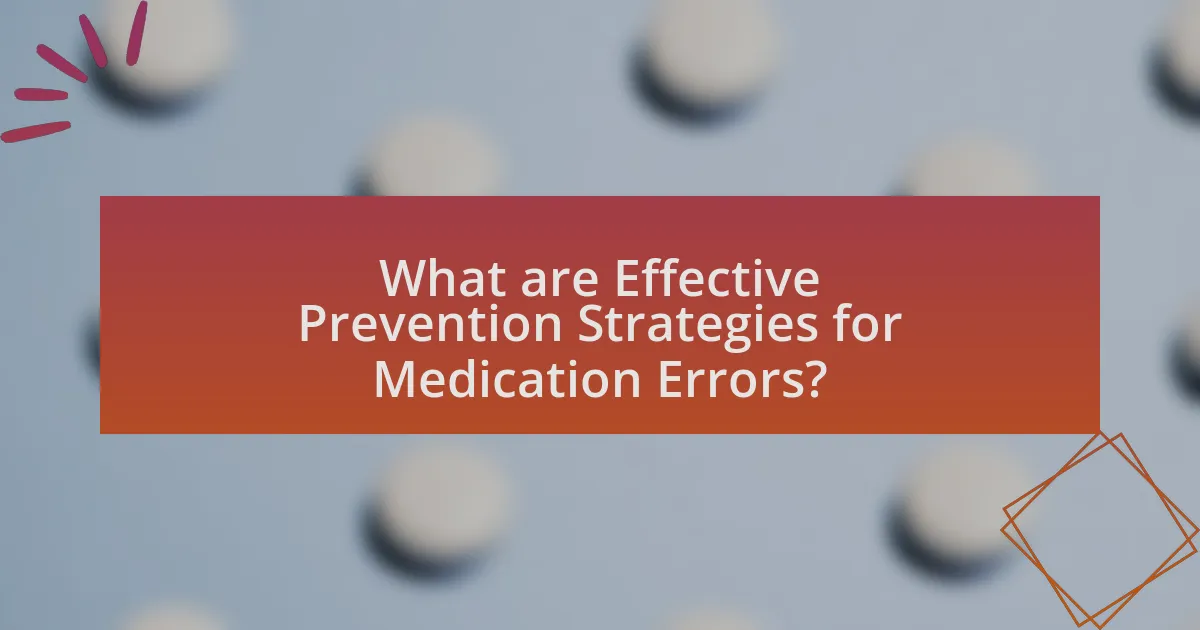
Effective prevention strategies for medication errors include implementing standardized protocols, utilizing technology such as electronic prescribing systems, and enhancing staff education and training. Standardized protocols, such as the use of checklists and double-check systems, help ensure that medications are administered correctly. Electronic prescribing systems reduce the risk of misinterpretation of handwritten prescriptions, as studies show that electronic systems can decrease medication errors by up to 50%. Additionally, ongoing education and training for healthcare staff on medication management and error prevention are crucial, as research indicates that well-trained staff are less likely to make errors.
How can healthcare providers improve medication safety?
Healthcare providers can improve medication safety by implementing standardized protocols for prescribing, dispensing, and administering medications. Standardized protocols reduce variability and minimize the risk of errors, as evidenced by a study published in the Journal of Patient Safety, which found that hospitals using standardized medication administration processes saw a 30% reduction in medication errors. Additionally, healthcare providers should utilize electronic health records (EHRs) with clinical decision support systems that alert providers to potential drug interactions and allergies, further enhancing patient safety. Research indicates that EHRs can decrease adverse drug events by up to 50% when integrated effectively into clinical workflows.
What training and education are necessary for healthcare professionals?
Healthcare professionals require a combination of formal education, clinical training, and ongoing professional development to ensure competency in their roles. Typically, this includes obtaining a relevant degree, such as a Bachelor of Science in Nursing or a Doctor of Medicine, followed by supervised clinical practice to gain hands-on experience. Additionally, healthcare professionals must complete continuing education courses to stay updated on best practices, including medication safety protocols, which are crucial for preventing medication errors. For instance, the Institute of Medicine emphasizes the importance of education and training in reducing medication errors, highlighting that well-trained professionals are essential for patient safety.
How can standardization of processes reduce errors?
Standardization of processes can reduce errors by creating consistent procedures that minimize variability in tasks. When healthcare professionals follow standardized protocols, the likelihood of mistakes decreases because everyone adheres to the same guidelines, reducing confusion and miscommunication. For instance, a study published in the Journal of Patient Safety found that implementing standardized medication administration processes led to a 30% reduction in medication errors. This evidence supports the assertion that standardization enhances clarity and reliability in healthcare practices, ultimately improving patient safety.
What role do patients play in preventing medication errors?
Patients play a crucial role in preventing medication errors by actively participating in their own healthcare management. By maintaining an accurate list of their medications, including dosages and schedules, patients can help healthcare providers avoid prescribing errors. Furthermore, patients should communicate openly with their healthcare team about any allergies, side effects, or concerns regarding their medications. Research indicates that when patients are engaged in their treatment plans, the likelihood of medication errors decreases significantly, as evidenced by a study published in the Journal of Patient Safety, which found that patient involvement can reduce medication discrepancies by up to 50%.
How can patients be educated about their medications?
Patients can be educated about their medications through comprehensive communication strategies that include clear labeling, counseling sessions, and educational materials. Effective communication from healthcare providers ensures that patients understand the purpose, dosage, and potential side effects of their medications. Studies show that when patients receive verbal and written instructions, their adherence to medication regimens improves significantly, reducing the likelihood of medication errors. For instance, a study published in the Journal of the American Pharmacists Association found that patients who received detailed counseling were 30% more likely to take their medications correctly compared to those who did not receive such education.
What strategies can patients use to ensure medication safety?
Patients can ensure medication safety by actively engaging in their healthcare, which includes verifying medication information, maintaining an updated medication list, and communicating effectively with healthcare providers. By confirming the name, dosage, and purpose of each medication with pharmacists or doctors, patients can prevent errors. Keeping a comprehensive list of all medications, including over-the-counter drugs and supplements, helps avoid dangerous interactions. Additionally, patients should ask questions about their medications, report any side effects, and ensure they understand the instructions for use. These strategies are supported by studies indicating that patient involvement significantly reduces medication errors and enhances overall safety in medication management.
What are the best practices for minimizing medication errors?
The best practices for minimizing medication errors include implementing standardized protocols, utilizing technology such as electronic prescribing, and ensuring effective communication among healthcare providers. Standardized protocols, such as the use of checklists and guidelines, help reduce variability in medication administration, thereby decreasing the likelihood of errors. Electronic prescribing systems enhance accuracy by automatically checking for drug interactions and allergies, which has been shown to reduce medication errors by up to 50%. Effective communication, including clear labeling and thorough patient education, ensures that all parties involved understand the medication regimen, further minimizing the risk of errors.
How can regular audits and feedback improve medication safety?
Regular audits and feedback can significantly improve medication safety by identifying and addressing potential errors in medication administration and prescribing processes. These systematic evaluations allow healthcare organizations to monitor compliance with established protocols, ensuring that medications are prescribed, dispensed, and administered correctly. For instance, a study published in the Journal of Patient Safety found that implementing regular audits reduced medication errors by 30% in a hospital setting. Feedback from these audits helps healthcare professionals understand their performance, recognize areas for improvement, and adopt best practices, ultimately leading to enhanced patient safety and reduced adverse drug events.
What systems can be implemented to track and analyze medication errors?
Electronic health record (EHR) systems can be implemented to track and analyze medication errors. These systems facilitate the documentation of medication administration, provide alerts for potential drug interactions, and enable the collection of data on medication errors for analysis. Research indicates that EHRs can reduce medication errors by up to 50% when integrated with clinical decision support systems, which provide real-time guidance to healthcare providers. Additionally, incident reporting systems allow healthcare professionals to report medication errors anonymously, fostering a culture of safety and continuous improvement. These systems collectively enhance the ability to identify trends, root causes, and areas for intervention in medication management.
